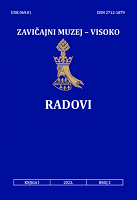Rezultati arheoloških istraživanja na lokalitetu Kundruci kod Visokog (prethodno saopštenje)
Results of archaeological excavations at the site of Kundruci near Visoko (preliminary report)
Author(s): Adnan Kaljanac, Jesenko HadžihasanovićSubject(s): Archaeology, Local History / Microhistory, Prehistory
Published by: JU Zavičajni muzej – Visoko
Keywords: Neolithic; Kundruci; Visoko; archaeological excavations; geophysics;
Summary/Abstract: In the course of 2020, two separate archaeological campaigns were conducted at the site of Kundruci in the village of Hadžići near Visoko. The first campaign was implemented between July and August 2020, and its goal was to identify the archaeological potential of the site. To that end, the archaeological excavation of twenty-one archaeological trenches and a test pit (approx. 158 square meters of the combined surface] was organized. Additionally, a geophysical survey using the RM85 Resistance Meter was performed with the aim of clarifying doubts related to earlier geophysical surveys of the site Kundruci. Based on the results of the geophysical surveys from the first archaeological campaign, it was decided to organize a second archaeological research campaign during October and November of the same year. On that occasion two test pits and the seven areas (approx. 354 square meters of the combined surface] were opened and three stone structures were found (K-l, K-2, K-3]. From these three stone structures, K-2 could be roughly dated to the period from the late stages of Middle Neolithic to the early stages of Late Neolithic. A detailed excavation of the archaeological trenches and test pits revealed 2799 archaeological finds, of which 1049 were found during the first archaeological campaign, and 1750 were found during the second archaeological campaign. These finds can be roughly dated to the Late Neolithic based on the decoration style of the pottery and presence of both rough and polished stone tools. The results of the archaeological excavations and analysis of finds and features made it possible to identify more precisely the potential of the site of Kundruci. In a typological sense, the Neolithic material has similarities with the material found in earlier excavations in Kundruci as well as at the site of Okolište. Based on the research carried out, it is safe to say that the inhabited area of the site of Kundruci represented a significant geographical position during the late Neolithic and it played an important role in the context of Neolithic possibilities of communication, relationships and distribution of cultural influences. Taking into account the area of wider distribution of finds identified during visual inspections of the neighbouring plots surfaces, which have not been the subject of previous archaeological research, it is quite clear that in the case of Kundruci we can talk about a larger settlement complex that occupied a small valley along the river Bosna. In this context it is necessary to emphasize the need to research a much wider area, which would en compass the area of neighbouring plots as well. In this way, not only the spatial scope of the entire settlement would be identified, but also it could be formed a more detailed picture of the relationship of the researched part and a found object with the rest of the site, potential housing buildings and the like.
Journal: Radovi Zavičajnog muzeja - Visoko
- Issue Year: 1/2022
- Issue No: 2
- Page Range: 9-71
- Page Count: 63
- Language: Bosnian

